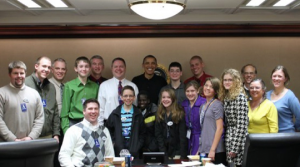
November 14, 2011
By Sarah Certa ’11
WSU-Rochester professor’s program earns White House visit.
There are a few ways to get your foot inside the White House. While you might not guess that zebra fish would be the ticket, for several students, scientists, and educators, those little fish swam a long way.
In recent years, Winona State University-Rochester, Rochester Public Schools, and the Mayo Clinic have collaborated to strengthen science, technology, engineering, and math (STEM) education in elementary classrooms.
The partnership, named the Integrated Science Education Outreach (InSciEdOut), is “an authentic opportunity for our pre-service teachers to stretch themselves as scientists, and as teachers,” says Maggie Hoody, assistant professor of education at WSU-Rochester.
At the core of the project is Rochester’s Lincoln K-8 Choice school’s research on zebra fish, which share 75-percent of our genetic code. Because the embryo growth of zebra fish takes place outside of the fish, students are able to observe the development of the two-day gestation period, as well as blood circulation and other processes.
Last winter, eight Lincoln Choice students, along with several educators and scientists from WSU-Rochester, Rochester Public Schools, and the Mayo Clinic, demonstrated the zebra fish project’s impact at the country’s largest general science conference in Washington, D.C.
The group toured the White House and received a surprise visit from President Obama, who commended InSciEdOut for its success in demonstrating that partnerships can make dramatic changes in science proficiency in American public schools.
Lincoln students have also had opportunities to work alongside scientists in the Mayo Clinic’s zebra fish research lab, testing modules developed by their teachers. The students gave their teachers feedback on how well the modules worked, exemplifying InSciEdOut’s focus on both student and teacher development, as well as communication and partnership between students and teachers.
Since the start of InSciEdOut’s efforts, substantial improvements in science proficiency have been seen among Lincoln’s K-8 students, and over half of eighth-grade students received “Exceeds Expectations” in state science standards, making Lincoln Choice the only school in Minnesota where science excellence is now the norm.

